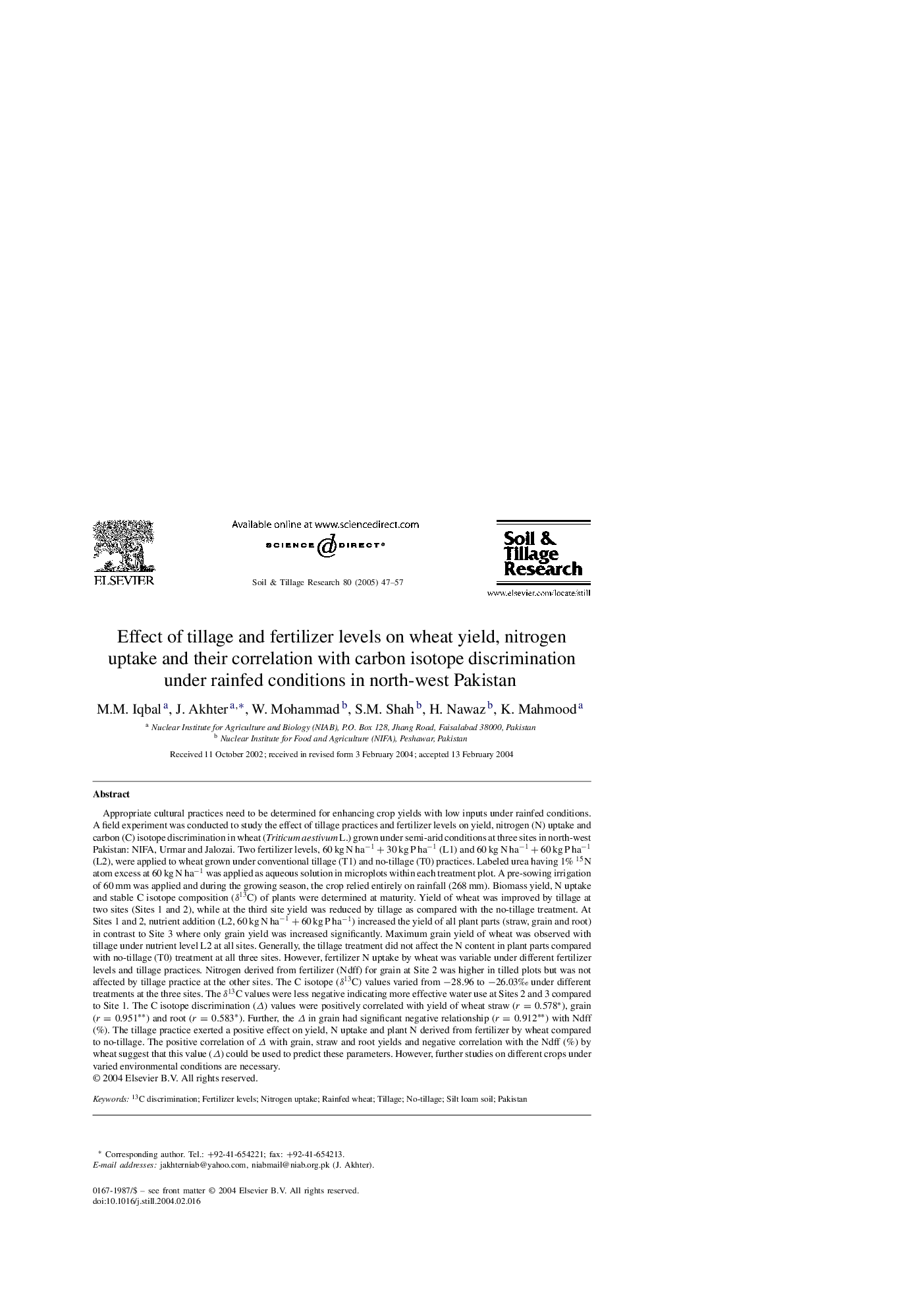| کد مقاله | کد نشریه | سال انتشار | مقاله انگلیسی | نسخه تمام متن |
|---|---|---|---|---|
| 9642678 | 513126 | 2005 | 11 صفحه PDF | دانلود رایگان |
عنوان انگلیسی مقاله ISI
Effect of tillage and fertilizer levels on wheat yield, nitrogen uptake and their correlation with carbon isotope discrimination under rainfed conditions in north-west Pakistan
دانلود مقاله + سفارش ترجمه
دانلود مقاله ISI انگلیسی
رایگان برای ایرانیان
کلمات کلیدی
موضوعات مرتبط
مهندسی و علوم پایه
مهندسی انرژی
انرژی های تجدید پذیر، توسعه پایدار و محیط زیست
پیش نمایش صفحه اول مقاله

چکیده انگلیسی
Appropriate cultural practices need to be determined for enhancing crop yields with low inputs under rainfed conditions. A field experiment was conducted to study the effect of tillage practices and fertilizer levels on yield, nitrogen (N) uptake and carbon (C) isotope discrimination in wheat (Triticum aestivum L.) grown under semi-arid conditions at three sites in north-west Pakistan: NIFA, Urmar and Jalozai. Two fertilizer levels, 60kgNhaâ1+30 kg P haâ1 (L1) and 60kgNhaâ1+60 kg P haâ1 (L2), were applied to wheat grown under conventional tillage (T1) and no-tillage (T0) practices. Labeled urea having 1% 15N atom excess at 60 kg N haâ1 was applied as aqueous solution in microplots within each treatment plot. A pre-sowing irrigation of 60 mm was applied and during the growing season, the crop relied entirely on rainfall (268 mm). Biomass yield, N uptake and stable C isotope composition (δ13C) of plants were determined at maturity. Yield of wheat was improved by tillage at two sites (Sites 1 and 2), while at the third site yield was reduced by tillage as compared with the no-tillage treatment. At Sites 1 and 2, nutrient addition (L2, 60kgNhaâ1+60 kg P haâ1) increased the yield of all plant parts (straw, grain and root) in contrast to Site 3 where only grain yield was increased significantly. Maximum grain yield of wheat was observed with tillage under nutrient level L2 at all sites. Generally, the tillage treatment did not affect the N content in plant parts compared with no-tillage (T0) treatment at all three sites. However, fertilizer N uptake by wheat was variable under different fertilizer levels and tillage practices. Nitrogen derived from fertilizer (Ndff) for grain at Site 2 was higher in tilled plots but was not affected by tillage practice at the other sites. The C isotope (δ13C) values varied from â28.96 to â26.03â° under different treatments at the three sites. The δ13C values were less negative indicating more effective water use at Sites 2 and 3 compared to Site 1. The C isotope discrimination (Î) values were positively correlated with yield of wheat straw (r=0.578â), grain (r=0.951ââ) and root (r=0.583â). Further, the Î in grain had significant negative relationship (r=0.912ââ) with Ndff (%). The tillage practice exerted a positive effect on yield, N uptake and plant N derived from fertilizer by wheat compared to no-tillage. The positive correlation of Î with grain, straw and root yields and negative correlation with the Ndff (%) by wheat suggest that this value (Î) could be used to predict these parameters. However, further studies on different crops under varied environmental conditions are necessary.
ناشر
Database: Elsevier - ScienceDirect (ساینس دایرکت)
Journal: Soil and Tillage Research - Volume 80, Issues 1â2, January 2005, Pages 47-57
Journal: Soil and Tillage Research - Volume 80, Issues 1â2, January 2005, Pages 47-57
نویسندگان
M.M. Iqbal, J. Akhter, W. Mohammad, S.M. Shah, H. Nawaz, K. Mahmood,